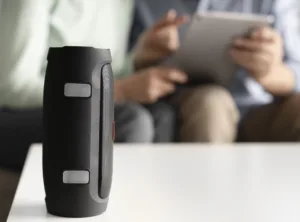When you purchase through links on our site, we may earn an affiliate commission. This doesn’t affect our editorial independence.
Most people walk into electronics stores asking which bluetooth speaker gets loudest. Wrong question entirely. What to consider in Bluetooth speakers beyond volume actually determines whether buyers love or hate their purchase six months later. This reality becomes clear after experiencing three different “loud” speakers that sounded terrible.
What Sound to Consider in Bluetooth Speakers
 Frequency response numbers reveal everything volume specs hide. Look for 20Hz-20kHz range – anything less means missing chunks of music. One speaker claimed “deep bass” but only went down to 60Hz. Hip-hop ended up sounding like elevator music.
Frequency response numbers reveal everything volume specs hide. Look for 20Hz-20kHz range – anything less means missing chunks of music. One speaker claimed “deep bass” but only went down to 60Hz. Hip-hop ended up sounding like elevator music.
Multiple drivers beat single drivers every time. Separate woofers handle bass while tweeters manage highs. Single-driver speakers try doing everything and fail at most of it. Reddit’s audiophile community argues about this constantly, but they’re spot-on about driver separation benefits.
DSP chips work magic behind the scenes. They prevent distortion before it happens and balance frequencies automatically. Cheap speakers skip this entirely – another reason they sound harsh at higher volumes.
Consider Battery Performance Over Marketing Claims in Bluetooth Speakers
Those “30-hour battery life” stickers lie through their teeth. That’s at minimum volume with bass boost disabled. Real-world usage at decent volumes? Expect 6-10 hours max from most speakers.
Fast charging saves more headaches than extra battery capacity. Forgot to charge overnight? Three hours plugged in should get through most events. This becomes obvious during camping trips when someone’s speaker dies during Saturday night festivities.
Automatic sleep modes preserve battery when music stops. Speakers that stay connected but idle still drain power. Smart ones shut down after twenty minutes of silence.
Look Out For Bluetooth Versions
Bluetooth 4.2 speakers drop connections constantly. Walls, microwaves, other devices – everything interferes. Bluetooth 5.0 fixed most of these problems with better range and stability. Don’t buy anything older unless it’s heavily discounted.
Multi-device pairing eliminates the “disconnect your phone so mine works” dance at parties. Good speakers remember 6-8 devices and switch between them seamlessly. Bluetooth SIG documentation explains how this works technically.
Backup connections save users when wireless fails. USB-C ports often handle audio input, not just charging. 3.5mm jacks work with everything – even that ancient iPod collecting dust.
Weather Resistance Ratings Explained
IPX4 handles rain and pool splashes from any direction. Perfect for outdoor parties where drinks get spilled and weather changes quickly. IPX7 survives brief underwater adventures but saltwater still kills electronics.
Testing proves these ratings mean something real. One IPX7 speaker fell in a lake during a fishing trip. Worked perfectly after drying out, though the experience aged everyone present several years. [Consumer Reports durability testing](https://www.consumer reports.org/cro/about-us/our-tests/index.htm) shows these ratings translate to actual protection.
Sand and dust cause more problems than water in many situations. Look for IP ratings with dust protection when hitting beaches or construction sites regularly.
Build Quality Shows Up Long-Term
Plastic housings rattle themselves apart over time. Metal or composite materials last longer and sound cleaner. Cheap speakers literally shake themselves to death – screws loosen, grilles fall off, drivers get damaged.
Rubberized edges prevent slides off tables and absorb impact from drops. Sounds minor until speakers take headers onto concrete. Those little details add up over months of regular use.
Button placement matters more than expected. Speakers with controls on top get accidentally pressed when grabbed. Side or back controls work better for portable units.
Extra Features you Should Consider Before Getting a Bluetooth Speaker
What to Consider in Bluetooth Speakers include;
Built-in microphones enable hands-free calls without reaching for phones. Quality varies wildly though – test this feature if planning regular use. Some speakers sound like talking through tin cans.
True wireless stereo pairing creates actual left-right separation with two identical speakers. Single speakers fake stereo by mixing channels. Real stereo sounds dramatically wider and more engaging.
Wireless charging pads built into speaker tops seem gimmicky but prove surprisingly useful. Nightstand speakers become phone charging stations – one less cable to manage.







